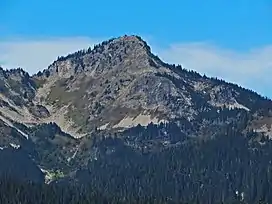| Copper Mountain | |
|---|---|
 Copper Mountain seen from the southeast | |
| Highest point | |
| Elevation | 6,302 ft (1,921 m)[1] |
| Prominence | 720 ft (220 m)[2] |
| Coordinates | 46°47′51″N 121°49′40″W / 46.7975341°N 121.8276859°W[1] |
| Geography | |
 Copper Mountain Location of Copper Mountain in Washington  Copper Mountain Copper Mountain (the United States) | |
| Location | Mount Rainier National Park Pierce County, Washington, U.S. |
| Parent range | Cascades |
| Topo map | USGS Mount Rainier West |
| Climbing | |
| Easiest route | Scrambling[3] |
Copper Mountain is a 6,302-foot (1,921-metre) mountain summit located in Mount Rainier National Park in Pierce County of Washington state.[1] Part of the Cascade Range, it is situated near the base of the Success Cleaver, overlooking Indian Henry's Hunting Ground. Its nearest neighbor is Iron Mountain 0.3 miles (0.48 km) to the south, and its nearest higher peak is Pyramid Peak, 1.0 mile (1.6 km) to the northeast.[3][2] The summit provides views of Mount Rainier, Mount Adams, Mount St. Helens, and peaks of the Tatoosh Range. Precipitation runoff from Copper Mountain drains into Tahoma Creek and Fishers Horn Pipe Creek, which are both tributaries of the Nisqually River. There were great hopes in the late 1800s that mines on Mount Rainier could be a source of precious metals such as copper, silver, and gold.[4] This landform's toponym was officially adopted in 1932 by the United States Board on Geographic Names.[1]
Climate

Copper Mountain is located in the marine west coast climate zone of western North America.[5] Most weather fronts originate in the Pacific Ocean, and travel northeast toward the Cascade Mountains. As fronts approach, they are forced upward by the peaks of the Cascade Range (Orographic lift), causing them to drop their moisture in the form of rain or snowfall onto the Cascades. As a result, the west side of the Cascades experiences high precipitation, especially during the winter months in the form of snowfall. During winter months, weather is usually cloudy, but, due to high pressure systems over the Pacific Ocean that intensify during summer months, there is often little or no cloud cover during the summer.
See also
References
- 1 2 3 4 "Copper Mountain". Geographic Names Information System. United States Geological Survey, United States Department of the Interior. Retrieved 2019-10-12.
- 1 2 Copper Mountain, listsofjohn.com
- 1 2 "Copper Mountain, Washington". Peakbagger.com.
- ↑ Mount Rainier National Park Place Names. Gary Fuller Reese (author), 2009.
- ↑ Beckey, Fred W. Cascade Alpine Guide, Climbing and High Routes. Seattle, WA: Mountaineers Books, 2008.
External links
- Weather forecast: Copper Mountain
- National Park Service web site: Mount Rainier National Park